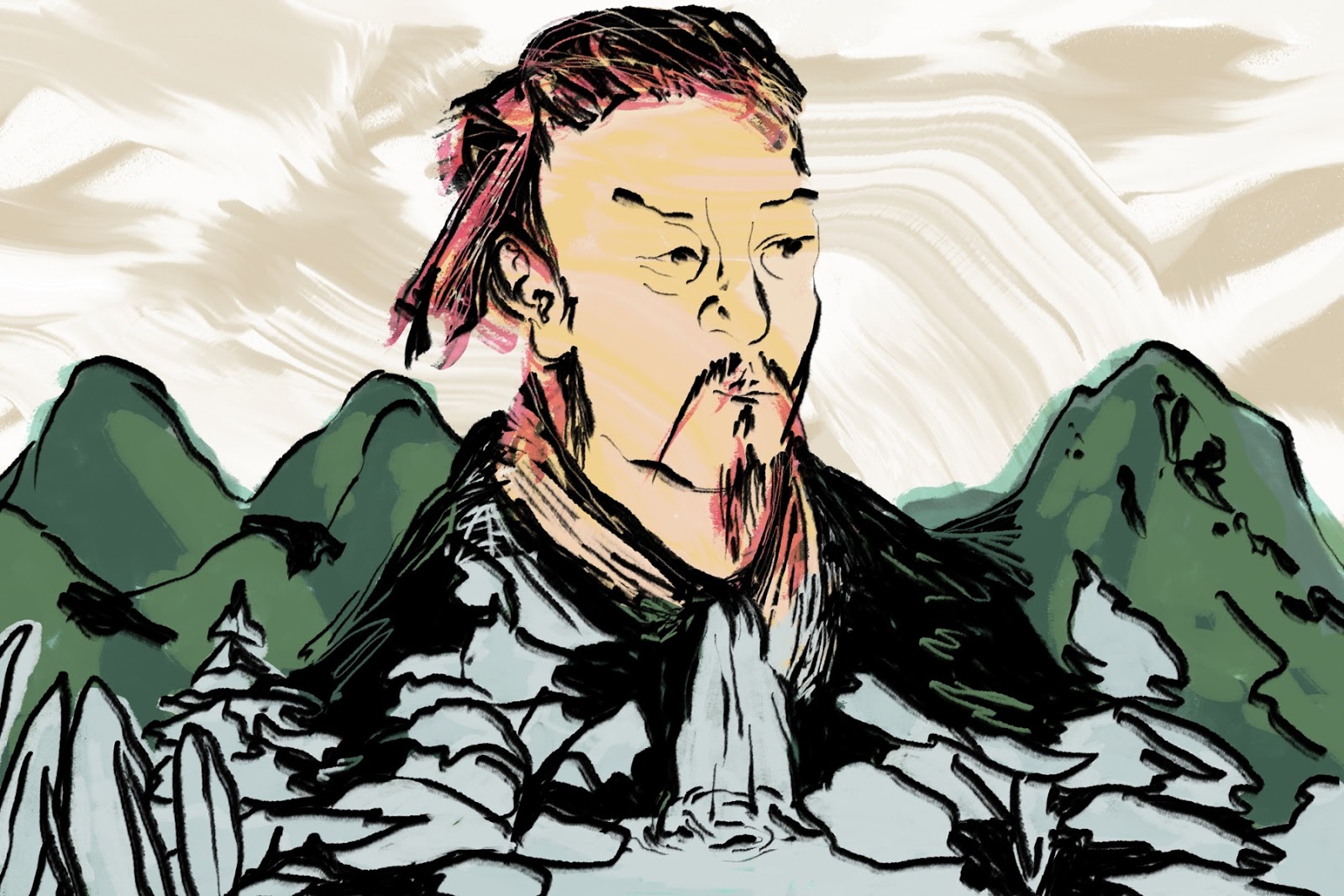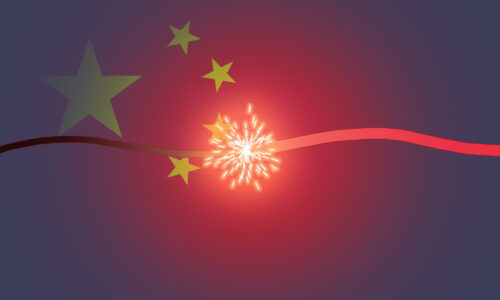Water rabbits and logs: The nature of Sun Tzu’s war, reexamined

Sun Tzu’s The Art of War is one of China’s most excerpted pieces of text, cited by everyone from Bill Belichick (“Every battle is won before it is fought”) to Tony Soprano (“Balk the enemy’s power; force him to reveal himself”).
But misconceptions still abound, specifically as it pertains to the actual element of war.
Illustration by Anna Vignet

Last Tuesday, rumbling under fleets of armored vehicles, Beijing boasted its ballistic missiles and deep sea drones. The 70th anniversary military parade announced China’s readiness for future — more so than modern — warfare. However, it is still ancient warfare for which China is most famous. This is because of Sun Tzu’s The Art of War (孙子兵法 sūnzi bīngfǎ), a military treatise written in the late Spring and Autumn Period (roughly 5th century BC).
Sun Tzu’s influence continues to ripple across popular and political culture. Dominic Cummings, the political strategist behind Brexit and the Boris Johnson premiership, often cites Sun Tzu. In previous decades, revolutionaries, sports coaches, CEOs, and even Tony Soprano have mentioned The Art of War as an inspiration. But what makes the handbook so enduring and universal is its counterintuitive distance from actual warfare. Sun Tzu offers no blood, no clanging weapons, and no celebratory killing. Instead, it is replete with natural imagery, featuring cascading water, waxing moons, and rolling logs.
There are two ways to understand this. First, Sun Tzu’s natural imagery enforces a key distinguishing principle: that conflict is to be averted, not glorified. Natural imagery euphemizes violence and displaces its glorification with the mundane. Second, Sun Tzu’s natural imagery possesses explanatory power. It makes strategic principles intelligible to the common commander. Far from gratuitous embellishment, Sun Tzu’s natural imagery is as strategic as his advice.
Conflict aversion
“There has never been a state that has benefited from an extended war.”
— From Roger T. Ames’s Sun Tzu: The Art of Warfare
Sun Tzu’s conflict aversion may seem counterintuitive, but conflict aversion is not the same as conquest aversion, and it is certainly not pacifism. Sun Tzu would simply rather win without a fight: “To win a hundred victories in a hundred battles is not the highest excellence,” he writes, as translated by Roger T. Ames. Rather, “the highest excellence is to subdue the enemy’s army without fighting at all.” In failing to win by attack, Sun Tzu advises that “the best military policy is to attack strategies; the next to attack alliances; the next to attack soldiers; and the worst to attack walled cities.” Only the two least preferential options in Sun Tzu’s four-step plan necessitate combat. He advances a low-risk, high-reward strategy in which violent conflict is explicitly deprecated. The Art of War is a misleading title, then (though one could say fittingly misleading, given Sun Tzu’s own proclivity for deception). It might as well be called The Art of Avoiding War While Winning.
Sun Tzu’s conflict aversion distinguishes him from near-contemporary thinkers who glorified it. Though Confucianism and Legalism are at intellectual odds, both situate war in a discourse of virtue ethics. The Zuozhuan (c. 400 BC), a Confucian text, recounts that at the Battle of Chengpu, “the ruler of Jin was able to attack through the power of virtue” (via Burton Watson’s The Tso chuan: Selections from China’s Oldest Narrative History). Military victory here both signals and results from moral excellence: war is glorious for the righteous victor. The Book of Lord Shang (c. 300 BC), a ruthlessly pragmatic Legalist text, also has elevated conceptions of fighting: “Strength produces force; force produces prestige; prestige produces virtue” (from Ames’s Sun Tzu: The Art of Warfare). For Lord Shang, the moral authority of leadership depends upon military might.
The Art of War, meanwhile, is a strictly pragmatic text devoted exclusively to its eponymous subject. What victory confers post-facto is no matter compared to achieving it: “To win in battle so that the whole world says ‘Excellent!’ is not the highest excellence.” Sun Tzu is conflict averse and resists glorifying war — and yet, as the title makes clear, conflict is occasionally unavoidable. Natural imagery helps resolve this tension.
Euphemistic and mundane
“Like a whetstone hurled at eggs.”
Sun Tzu’s natural imagery has a euphemistic quality, allowing him to address combat without indulging violence. In place of rampaging armies, Sun Tzu describes surging and relentless rivers: “The army…, launching its men into battle, can be likened to the cascading of pent-up waters thundering though a steep gorge”; rather than describing the destructive potential of ambush, Sun Tzu reimagines “the ‘surprise’ assault” to be “as boundless as the heavens and earth, and as inexhaustible as the rivers and seas.” Images of military power are outsourced to nature.
Sometimes Sun Tzu calls on impotent natural images to convey effective combat, further distancing his instructions from violence. “Be as swift as a scurrying rabbit,” The Art of War urges, “and the enemy will be too late to resist you.” Of all the creatures in the wild, the rabbit might seem like the least suited for a war treatise. The creature suggests flight more than fight, and dinner more than domination. But Sun Tzu is not trying to get the testosterone flowing. His central point lacks nothing: Speed and agility are essential in battle. To this end the bunny, as it scurries, suffices. In a similar example, Sun Tzu describes a marauding army as a “flock of sheep” driven “this way and that” by their commander. Reducing armies to bleating herbivores has none of the gusto we might expect. But Sun Tzu is concerned, again, only with the central principle: commanders must have total control of their ranks. Sun Tzu’s natural images — some powerful, some meek — dissociate The Art of Warfare from its subject without losing sight of it. The principle of conflict aversion is carried through Sun Tzu’s language.
Rabbits and sheep belong to a wider set of mundane images in The Art of War, which are a foil for conflict glorification. Perhaps the most mundane image appears in the passage on surprise attack. Sun Tzu advises “falling upon the enemy” as “a whetstone being hurled at eggs.” This image is almost comic in its anti-climax. Granted, a whetstone is more intimidating than a rabbit or flock of sheep, but eggs are a far cry from enemy skulls. Yet the image of crushing shells is crisp and destructive. Crucially, yolk runs where blood does not. Sun Tzu’s natural imagery lets him address violence without sexing it up. A studious general can map out his plan of attack without a hard-on.
Gravity, explained
“Rolling round boulders down a steep ravine.”
Sun Tzu’s mundane descriptions do more than sidestep glorified violence. They produce comprehensible writing. Sun Tzu’s intelligibility is not so much found in basic vocabulary as in common images. He draws on the natural sciences, allowing advisees to grasp new and complex strategic concepts. Sun Tzu writes: “It is the nature of logs and boulders that on flat ground, they are stationary, but on steep ground, they roll.” Preempting Sir Isaac Newton by over two millennia, Sun Tzu continues his lesson in gravitational acceleration: “The square in shape tends to stop but the round tends to roll.” The overarching military principle borne of Sun Tzu’s proto-physics is, “He who exploits the strategic advantage sends his men into battle like rolling logs and boulders.” Sun Tzu does not simply describe boulders for their destructive quality. He does so to instruct how to win by the power of angles, friction, and forces. Yet the hyper-technicality of all this is reduced by simple natural science conveyed through imagery.
Sun Tzu does not stop at gravitational acceleration. He is a scholar of ancient fluid dynamics too. Again foregrounding a natural analogy, Sun Tzu writes: “The position of troops can be likened to water.” Developing this comparison, he continues: “Just as the flow of water avoids high ground and rushes to the lowest point, so on the path to victory avoid the enemy’s strong points and strike where weak.” Sun Tzu translates war strategy into common experience. Ultimately, he does as he would have his commanders do on the battlefield: “Coordinate the ears and eyes of the men.”
“When able, seem to be unable; when ready, seem unready”
One wonders what Sun Tzu would make of the PRC’s military strategy, and the recent parade. On the one hand, in recent times, China has averted the lure of foreign conflict, though its provocations in the South China Sea should not be discounted. Sun Tzu might approve of this general conflict aversion. However, amid Beijing’s pageantry of arms, one cannot help but hear the murmur of some of Sun Tzu’s most famous lines: “When able, seem to be unable; when ready, seem unready.” Through Sun Tzu’s lens, China is either strategically flawed for flaunting its capabilities, or far more powerful than the parade lets on.
The Art of War is not just a military master class. It is a lesson in strategic communication. Sun Tzu’s natural imagery displaces the violent language that would intuitively populate a text centred on war. His aversion to conflict, and caution against glorifying it, are thus enforced. Crucially, these points — and many more complex ones — are conveyed in an entirely comprehensible language. The instrumental force of natural imagery gives new meaning to Sun Tzu’s advice that “unless you know the lay of the land — its mountains and forests, its passes and natural hazards, its wetlands and swamps— you cannot deploy the army on it.” Unless you know the lay of the land, you cannot deploy the army, because you cannot understand The Art of War.






